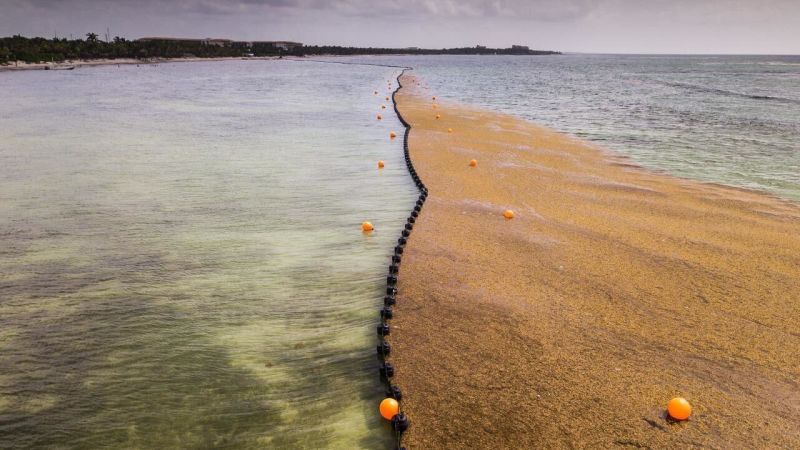Remote Sensing of Sargassum Biomass, Nutrients, and Pigments
Geophysical Research LettersMengqiu Wang, Chuanmin Hu, Jennifer Cannizzaro, David English, Xingxing Han, David Naar, Brian Lapointe, Rachel Brewton, Frank Hernandez
2018
Field and laboratory experiments are designed to measure Sargassum biomass per area (density), surface reflectance, nutrient contents, and pigment concentrations. An alternative floating algae index‐biomass density model is established to link the spectral reflectance to Sargassum biomass density, with a relative uncertainty of ~12%. Monthly mean integrated Sargassum biomass in the Caribbean Sea and central West Atlantic reached at least 4.4 million tons in July 2015. The average %C, %N, and %P per dry weight are 27.16, 1.06, and 0.10, respectively. The mean chlorophyll‐a (Chl‐a) concentration is ~0.05% of the dry weight. With these parameters, the amounts of nutrients and pigments can be estimated directly from remotely sensed Sargassum biomass. During bloom seasons, Sargassum carbon can account for ~18% of the total particulate organic carbon in the upper water column. This study provides the first quantitative assessment of the overall Sargassum biomass, nutrients, and pigment abundance from remote sensing observations, thus helping to quantify their ecological roles and facilitate management decisions.
View more
Characterizing a Sea Turtle Developmental Habitat Using Landsat Observations of Surface-Pelagic Drift Communities in the Eastern Gulf of Mexico
IEEE Journal of Selected Topics in Applied Earth Observations and Remote SensingRobert F Hardy, Chuanmin Hu, Blair Witherington, Brian Lapointe, Anne Meylan, Ernst Peebles, Leo Meirose, Shigetomo Hirama
2018
Compared with our understanding of most aspects of sea turtle biology, knowledge of the surface-pelagic juvenile life stages remains limited. Young North Atlantic cheloniids (hard-shelled sea turtles) are closely associated with surface-pelagic drift communities (SPDCs), which are dominated by macroalgae of the genus Sargassum. We quantified SPDCs in the eastern Gulf of Mexico, a region that hosts four species of cheloniids during their surface-pelagic juvenile stage. Landsat satellite imagery was used to identify and measure the areal coverage of SPDCs in the eastern Gulf during 2003-2011 (1323 images). Although the SPDC coverage varied annually, seasonally, and spatially, SPDCs were present year-round, with an estimated mean area of SPDC in each Landsat image of 4.9 km 2 (SD = 10.1). The area of SPDCs observed was inversely proportional to sea-surface wind velocity (Spearman's r = -0.33, p
View more
Septic systems contribute to nutrient pollution and harmful algal blooms in the St. Lucie Estuary, Southeast Florida, USA
Harmful AlgaeBrian E Lapointe, Laura W Herren, Armelle L Paule
2017
Nutrient enrichment is a significant global-scale driver of change in coastal waters, contributing to an array of problems in coastal ecosystems. The St. Lucie Estuary (SLE) in southeast Florida has received national attention as a result of its poor water quality (elevated nutrient concentrations and fecal bacteria counts), recurring toxic Microcystis aeruginosa blooms, and its proximity to the northern boundary of tropical coral species in the United States. The SLE has an artificially large watershed comprised of a network of drainage canals, one of which (C-44) is used to lower the water level in Lake Okeechobee. Public attention has primarily been directed at nutrient inputs originating from the lake, but recent concern over the importance of local watershed impacts prompted a one-year watershed study designed to investigate the interactions between on-site sewage treatment and disposal systems (OSTDS or septic systems), groundwaters, and surface waters in the SLE and nearshore reefs. Results provided multiple lines of evidence of OSTDS contamination of the SLE and its watershed: 1) dissolved nutrients in groundwaters and surface waters were most concentrated adjacent to two older (pre-1978) residential communities and the primary canals, and 2) sucralose was present in groundwater at residential sites (up to 32.0 μg/L) and adjacent surface waters (up to 5.5 μg/L), and 3) δ15N values in surface water (+7.5 o/oo), macroalgae (+4.4 o/oo) and phytoplankton (+5.0 o/oo) were within the published range (>+3 o/oo) for sewage N and similar to values in OSTDS-contaminated groundwaters. Measured δ15N values in M. aeruginosa became increasingly enriched during transport from the C-44 canal (∼5.8 o/oo) into the mid-estuary (∼8.0 o/oo), indicating uptake and growth on sewage N sources within the urbanized estuary. Consequently, there is a need to reduce N and P loading, as well as fecal loading, from the SLE watershed via septic-to-sewer conversion projects and to minimize the frequency and intensity of the releases from Lake Okeechobee to the SLE via additional water storage north of the lake. These enhancements would improve water quality in both the SLE and Lake Okeechobee, reduce the occurrence of toxic harmful algal blooms in the linked systems, and improve overall ecosystem health in the SLE and downstream reefs.
View more







